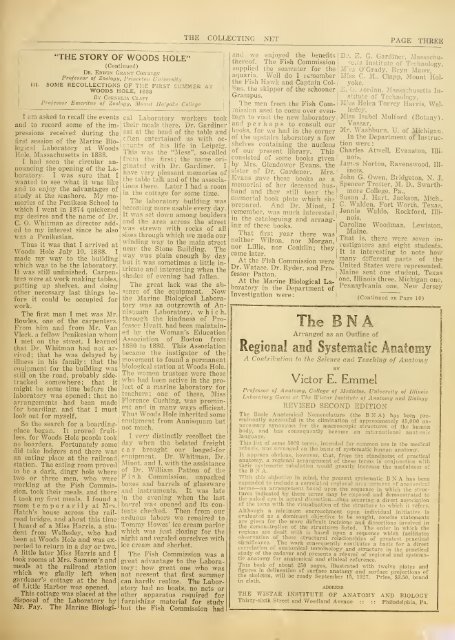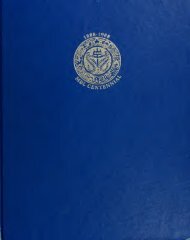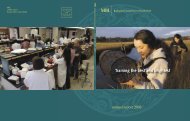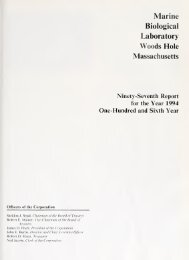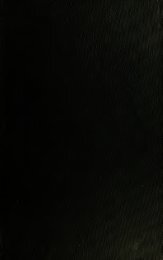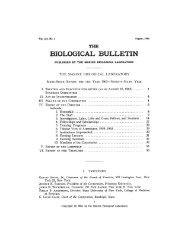View/Open - HPS Repository - Marine Biological Laboratory
View/Open - HPS Repository - Marine Biological Laboratory
View/Open - HPS Repository - Marine Biological Laboratory
- No tags were found...
Create successful ePaper yourself
Turn your PDF publications into a flip-book with our unique Google optimized e-Paper software.
i counts'jijIII."THE STORY OF WOODS HOLE"(Continued)Dr. Edwin Grai-it ConklinProfessor of Zoology, PrinceLon UniversitySOME RECOLLECTIONS OF TKE FIRST SUMMER ATWOODS HOLE, 1BS3By Cornelia ClappProfessor Emeritus of Zoology, Mount Hoiyoke CollegeI am asked to recall the eventsand to record some of the impressionsreceived during thefirst session of the <strong>Marine</strong> <strong>Biological</strong><strong>Laboratory</strong> at WoodsHole, Massachusetts in 1888.I had seen the circular announcingthe opening of the <strong>Laboratory</strong>.I v.'as sure that Iwanted to see what it was likeand to enjoy the advantages ofstudy at the seashore. My memoriesof the Penikese School towhich I went in 1874 quickenedmy desires and the name of Dr.C. 0. Whitman as director addedto my interest since he alsoPenikesian.was aThus it was that I arrived atWoods Hole July 10, 1888. Imade my way to the buildingwhich was to be the laboratory.It was still unfinished. Carpenterswere at work making tables,putting up shelves, and doingother necessary last things beforeit could be occupied forwork.The first man I met was Mr.Bowles, one of the carpenters.From him and from Mr. VanVleck, a fellow Penikesian whomI met on the street, I learnedthat Dr. Whitman had not arrived; that he was delayed byillness in his family; that thefor Woods Hole people tookequipment for the building wasstill on the road, probably sidetrackedsomewhere; that itmight be some time "before thelaboratory was opened; that noarrangements had been madefor boarding, and that I mustlook out for myself.So the search for a boardingplacebegan. It proved fruitless,no boarders. Fortunately somedid take lodgers and there wasan eating place at the railroadstation. The eating room provedto be a dark, dingy hole wheretwo or three men, who wereworking at the Fish Commission,took their meals, and thereI took m.y first meals. I found aroom temporarily at Mrs.Hatch's house across the railroadbridge, and about this timeI heard of a Miss Harris, a studentfrom Wellesley, who hadbeen at Woods Hole and was expectedto return in a day or two.A littlelater Miss Harris and Itook rooms at Mrs. Samson's andmeals at the railroad stationwhich we gladly left whengardener's cottage at the headof Little Harbor was opened.This cottage was placed at thedisposal of the <strong>Laboratory</strong> byMr. Fay. The <strong>Marine</strong> <strong>Biological</strong><strong>Laboratory</strong> workers tooktheir meals there. Dr. Gardinersat at the head of the table andcften entertained us with ac-of his life in Leipzig.This was the "Mess", so-calledfrom the first ; the name originatedwith Dr. Gardiner. Ihave vei-y pleasant memories ofthe table talk and of the associationsthere. Later I had a roomin the cottage for some tim.e.The laboratory building wasbecoming more usable every day.It was set down among bouldersand the area across the streetwas strewn with rocks of allsizes through which we made ourwinding way to the main streetnear the Stone Building. Theway was plain enough by daybut it was sometimes a little intricateand interesting when theshades of evening had fallen.The great lack was the absenceof the equipment. Nowthe <strong>Marine</strong> <strong>Biological</strong> <strong>Laboratory</strong>was an outgrowth of Annisquam<strong>Laboratory</strong>, which,through the kindness of ProfessorHyatt, had been maintainedby the Woman's EducationAssociation of Boston from1880 to 188G. This Associationbecame the instigator of themovement to found a permanentbiological station at Woods Hole.The women trustees were thosewho had been active in the projectof a marine laboratory forteachers; one of these. MissFlorence Gushing, was prominentand in many ways eflScient.Thus Woods Hole inherited someequipment from Annisquam butnot much.I very distinctly recollect theday when the delated freightcar bi-ought our longed-forenuipment. Dr. Whitman, Dr.Minot, and I, with the assistanceof Dr. William Patton of theFish Commission, unpackedboxes and barrels of glasswareand instruments. It was late'n the evening when the lastbarrel was opened and its contentschecked. Then from ourarduous labors we repaired toTommy Howes' ice cream parlorwhich was just closing for thenight and regaled ourselves withice cream and sherbet.The Fish Commission was agreat advantage to the Laboratoi-y;how great one who wasnot present that first summercan hardlv realize. The <strong>Laboratory</strong>had no boats, no nets orother apparatus required forfurnishing material for studybut the Fish Commission hadTHE COLLECTING NET PAGE THREEand we enjoyed the benefitsthereof. The Fish Commissionsupplied the seawater for theaquaria. Well do I rememberthe Fish Hawk and Captain Col-'ins, the skipper of the schoonerGrampus.The men from the Fish Commissionused to come over eveningsto visit the new laboratoryand perhaps to consult ourbooks, for we had in the cornerof the upstairs laboratory a fewshelves containing the nucleusof our present library. Thisconsisted of some books givenby Mrs. Glendower Evans, thesister Iof Dr. Gardener. Mrs.Evans gave these books as amemorial of her deceased hus-jband and they still bear the Imemorial book plate which sheprepared. And Dr. Minot, I'remember, was much interestedin the cataloguing and arrangingof these books.That first year there wasneither Wilson, nor Morgan, inor Lillie, nor Conklin; theyjcame later.At the Fish Commission wereDr. Watase, Dr. Ryder, and ProfessorPatton.jAt the <strong>Marine</strong> <strong>Biological</strong> <strong>Laboratory</strong>in the Department ofInvestigation were: IThe B N AArranged as an Outline ofDr. E. G. Gardiner, MassachusclIsInstitute of Technology,M:ss O'Grady, Bryn Mawr,Miss C. M.. Clapp, Mount Holyoke,E. 0. Jordan, Massachusetts Instituteof Technology,Miss Helen Torrey Harris, Wellesley,Miss Isabel Mulford (Botany).Vassar,Mr. Washburn, U. of Michigan.In the Department of Instructionwere:Charles Atwell, Evanston, Illinoia,.Tamos Norton, Ravenswood, Illinois,John G. Owen, Bridgeton, N. J.Spencer Trotter, M. D.,more College, Pa.,Swarth-Susan J. Hart, Jackson, Mich.,C. Walden, Fort Worth, Texas,Jennie Waldo, Rockford, Illinois,Caroline Woodman, Lewiston,Maine.That is, there were seven investigatorsand eight students.It is interesting to note hoAVmany difl^erent parts of theUnited States were represented.Maine sent one student, Texasone, Illinois three, Michigan one,Pennsylvania one. New Jersey(Continued on Page 10)Regional and Systematic AnatomyA Contribution to the Science and Teaching of AnatomyBYVictor E. EmmelProfessor of Anatomy, College of Medicine, University of Illinois<strong>Laboratory</strong> Guest at The Wistar Institute of Anatomy and BiologyREVISED SECOND EDITIONThe Basle Aniatomical Nomenclature (the B N A) has been preeminentlysuccessful in the elimination of approximately 45,000 unnecessarysynonjmis for the macroscopic structures of the humanbody, and has consequently become an international anatomiclanguage.This list of seme 5000 terms, intended for common use in the medical'schoois, was arranged on the basis of systematic human anatomy.It appears obvious, however, that, from the standpoiimt of practicalanatomy, .a regional arrangement of these terms in conjunction withtheir f.ystematic tabulation would greatly increase the usefulness ofthe B N A.With this objective in mind, the present systematic B N A has beenexpanded to include a correlated regional arrangement nf anatomicalterms—an arrangement based upon^the sequence in which the structuresindicated by these terms may be exposed and demonstra/ted tothe naked eye m actual dissection—^thus securing a direct associationof the term with the visualization of the structure to which it refers.Although a minimum encroachment upon individual initiative isevaluated as a dominant objective to be sought, concise statementsare given for the m.ore difficult incisions and dissections involved inthe demonstration of the structures listed. The order in which theregions are dealt with is based upon a sequence which facilitatesobservation of those structural relationships of greatest practicalsignificance. The work consequently contitutes a basis for a directcorrelation of anatomical terminology and structure in the practical.study of the cadaver and presents a resume of regional and systematicanatomy for anatomical and clinical reference.This book of about 250 pages, illustrated with twelve plates andfigures in delineation of surface anatomy and surface projections ofthe skeleton, will be ready September 15, 1927. Price, S3.50, boundm cloth.ADDRESSTHE WISTAR INSTITUTE OF ANATOMY AND BIOLOGYThirty-sixth Street and Woodland Avenue : : : : Philadelphia, Pa.


